Plan, assign and produce content for your SEO strategy, leveraging all of Semji's collaborative features!
What is the purpose of the Planning tab?
Summary
Semji's Planning tab helps you organize all your editorial production and write optimized content.
To do so, you can create two types of drafts: Updated Content and New Content. When you have launched a Focus Keywords analysis, the drafts appear in the list of contents in the Planning > Open drafts tab.
You assign these drafts, i.e. the writing mission, to the collaborators invited in the Semji Organization, and you define due dates for the completion of these missions.
Collaborators can assign different statuses to the content they are working on, to give you an idea of their progress in relation to your internal process: content in progress, awaiting review, approved...
You can build up an editorial schedule for the short, medium and long term, and easily monitor its progress. You can filter the list of contents to view the breakdown of contents among your editorial team, but you can also be alerted in case of late contents, or contents stuck at a stage of your process.
The Planning tab gathers all the operational production of your SEO content.
Composition of the Planning tab
The Planning tab consists of the following elements:
A table listing the drafts, at the center of the screen
This table proposes to visualize in columns the different information related to the identification of a draft and its management in your editorial planning:
- content title
- status
- the keyword focus chosen for the analysis
- the search volume for this keyword
- the draft's Content Score
- the collaborator in charge
- the target date of the content

A left sidebar, with sub-tabs
More details about sub-tabs below.
A filter bar
This is a link that allows you to add filter settings to the Drafts table below.

A search feature
By clicking on the magnifying glass, you can run a keyword search on the Title tags and Focus Keywords of the listed Drafts.
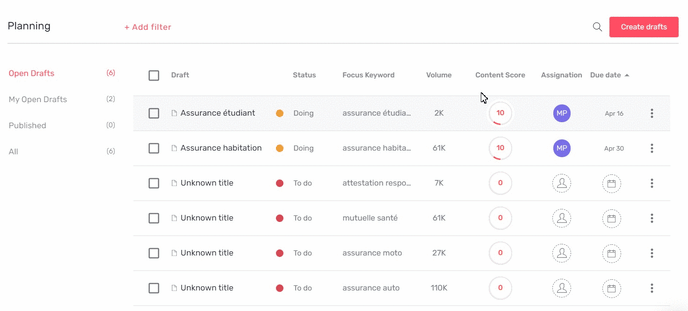
A “Create Draft” button
With this button, you can access the creation flow of one or more new drafts, which will automatically be added to the list of drafts in the schedule.

The Planning sub-tabs
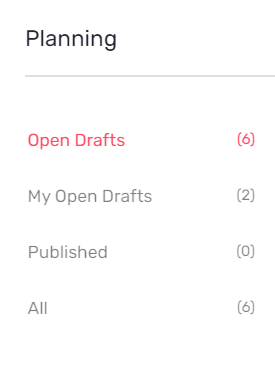
Open Drafts: to view all content in production
The Open Drafts sub-tab is the one a user is on by default when he clicks on the Planning tab. It shows all drafts, whether they are New Content or Updated Content, whether they are assigned to him or not. However, only content that is in the process of being produced or for which optimization work has not yet begun is listed here.
My Open Drafts: to filter the content assigned to me
Want to know at a glance which drafts are specifically assigned to you?
Each contributor who is assigned drafts can get a view of the contents he is in charge of by going to the left side menu and clicking on "My Open Drafts".
Published: to find finished and published content
You may want to identify the collaborator who optimized a specific content to congratulate him on its performance? Or simply reopen a draft to rework it according to the evolutions of Google and your competitors?
Content that has been completed and for which you have clicked on "Mark as Published" can be found in this tab. You can find all the content that has been drafted in the past but on which work is no longer in progress.
The Folder tree
Organize your drafts in folders to better organize your production. Like a tree structure in your email program or in Windows file explorer for example, you can create first level folders (parent) and second level folders (child).
The parent folders only display the content that you have specifically stored in them, and not the content stored in the child folders.
Some examples of how to organize your Planning tab using folders:
- New content on one side, existing content on the other
- Content to be produced for sales, end of year celebrations, editorial chestnuts...
- Content belonging to a specific semantic cocoon
- Blocked content waiting to be reread, isolated in a folder...
By default, all the drafts you create are stored in the "General" folder. You can put a content in a folder when you create it (after clicking on "New draft"), or once it is already created in the Planning. You can also easily change the folder of a content using the drop-down menu on the right. 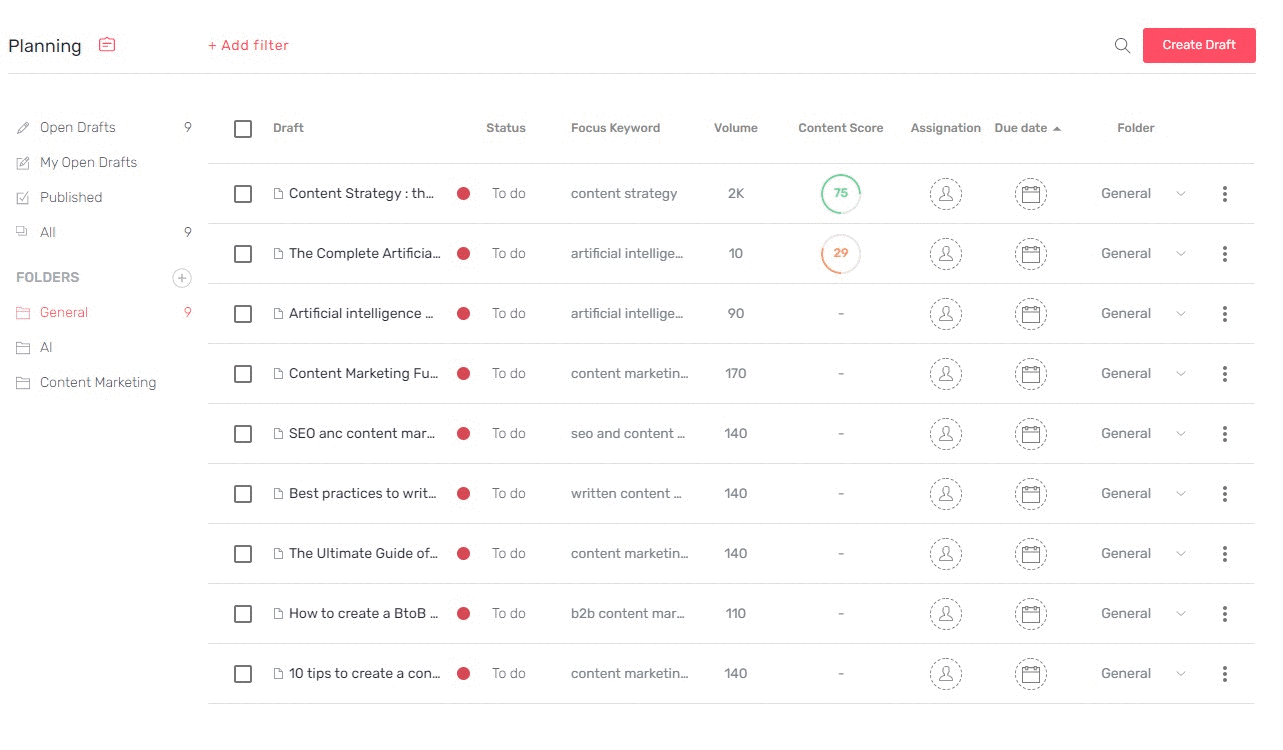
Functionalities of the Planning tab in detail
The Planning tab is where the editorial content is concentrated. You can easily add new content to your editorial planning by clicking on the "Create Draft" button or simply on the "+" button accessible from any Semji Platform screen.
- Create new content or optimize existing content
Once you have clicked on one of the Draft creation buttons, you are prompted to choose your Draft type: New or Updated, and then choose your Keyword Focus.
A New Content is a content that you start from a blank page.
Updated Content is content already online on your site, which you want to optimize to improve its current performance.
Reminder: You can also create multiple Drafts by importing several urls or by selecting several new Focus Keywords. These contents will all be imported into the Planning in the form of Drafts, with the assignment and Due Date information that you have entered. This way, you can add all the content you plan to create or optimize several months in advance in one go!
- Launch an analysis
When you have chosen the Focus Keywords of the contents to be optimized, you can launch the analyses.

By doing so, Semji launches its SEO analysis and recommendation algorithms. The SERP of the Focus Keyword is analyzed in a few milliseconds, as well as the competing contents. The SEO recommendations, which you will find in the Optimizations tab of each Draft, are generated in real time.
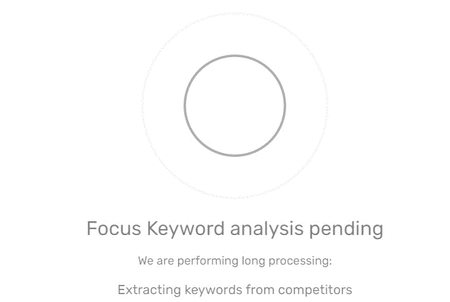
An analysis in progress is shown by a grayed Content Score in the planning table. This means that it is being calculated, and the whole operation may take several seconds.

When the Content Score is displayed - even if it shows 0 - it means that the analysis is complete, and the recommendations are fully accessible to work on your draft.
Note : When you run an analysis to add content to the Planning, you use one of your analysis credits included in your subscription package.
- Write content with the Drafts editor
From the Planning, click on the title of any content to access its editor, and the detailed recommendations provided by Semji.
Here you can make your additions and modifications directly. These are saved in real time.

From the content editor, return to the Planning at any time, without losing your actions, by using the arrow at the top left of the screen.
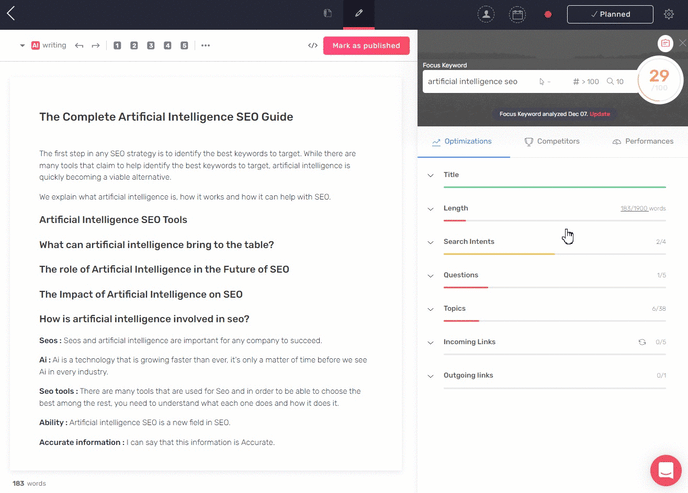
Organize production and collaboration between users
The Planning tab was designed to facilitate collaboration within your team. It is ideal for managing an editorial project of any size.
- Assigning collaborators
You can assign a draft to a collaborator to in 2 ways:
- from the Planning tab
- directly from the Draft's editor
From the Planning tab, simply click on the Assignment symbol corresponding to the Draft you wish to assign. A drop-down list appears, suggesting the different members of your Organization. You can decide to assign the person who is responsible for the first step of your process, for example the person in charge of writing the content. You can then change the person assigned if the Content Status changes, for example if another of your collaborators is in charge of proofreading.
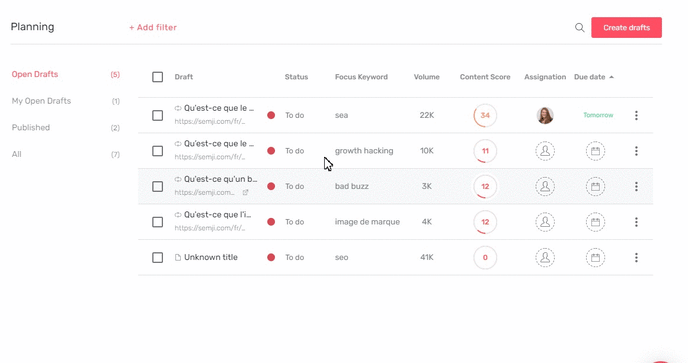
- Manage Content status
In the similar way as the assignment of collaborators, you can change the status of the content from the Planning tab or from the Draft editor directly.
The content status allows you to indicate a status for your content or the stage it is at within your internal writing process: the content is to be done; the content is being written; the content is awaiting proofreading; the content is being edited before publication...
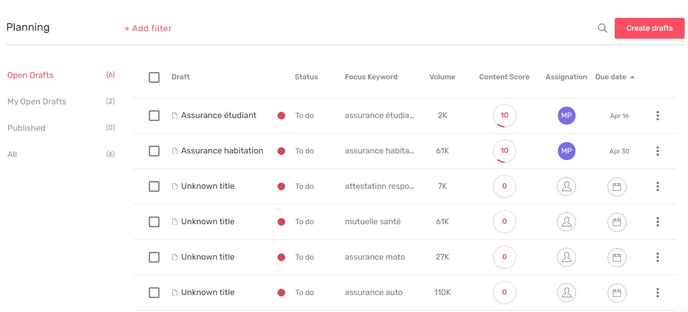
Note: the "Published" status is automatically set when you or one of your collaborators click on the "Mark as Published" button inside the Draft Editor. This means that you report that you have published the content in your CMS and that it is now accessible online.
- View a content optimization level thanks to the Content Score
At any time, in the planning, check the updated Content Score of the listed drafts. Content that is currently being written can see its Content Score evolve significantly during a work session on Semji!
This way, you have an overview of the quality level of the drafts your team is working on, and their evolution.
When you create a new content, the Content Score is set to 0. When you import existing content, the Content Score takes into account the editorial content already in the Draft. In this case, your content score gives you an idea of your content's optimization level considering Google's requirements and performing contents on the 1st page. You can quickly see what needs to be done thanks to Semji's recommendations.
- Manage deadlines
As with any writing project, you need to set goals: quantity, quality and deadlines! You can define due dates for the different drafts. It's up to you to determine whether the Due Date you enter is the final publication date or the date on which the Draft must change status to move on to the next stage of your production process.
Note: remember to communicate this process to your team as well as the terms and conditions of Due Date modifications, to avoid misunderstandings and delays!
To assign a Due Date to a Draft, you can go through the Planning tab or directly through a Draft's editor. From the Planning tab, click on the Due Date symbol and enter the chosen date using the calendar. Click on OK as soon as the date is selected.
You can also delete a previously entered date, to show that the draft is not yet scheduled. Click on the date, and click on "Clear" in the bottom left corner of the calendar.
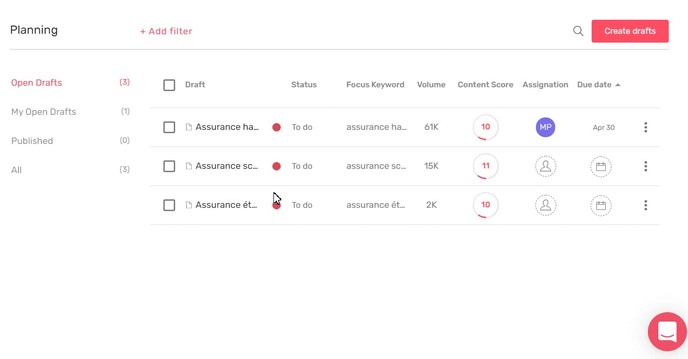
Manage contents
- Sort and filter your drafts
You can change the order in which the contents are displayed in the central table by clicking on a column heading. Depending on the value contained in the column, if it is numeric or textual :
- At the first click, you order the contents in ascending order or in alphabetical order (from A to Z)
- With the second click, you order by descending order or from Z to A
Each of the columns allows this ordering, from the title of the Draft to the Due Date.
The Planning tab also includes a filter feature, above the central table. You can add criteria to filter the list of displayed content and see only a portion of your schedule. You can combine several filters, mixing both numerical and textual data. 
For example, you can filter Drafts according to the :
- assigned collaborator
- Content Score
- Due Date
- chosen Focus Keyword
- Focus Keyword search volume
- content status
- content's title
- kind of content (New ou Updated)
Some examples :
A filter on Focus Keywords
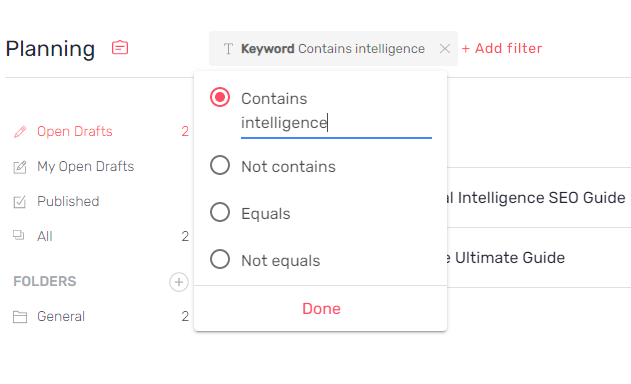
A filter on the Focus Keyword search volumes
 A filter on content status
A filter on content status
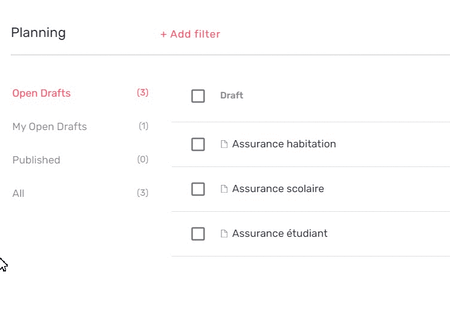
A filter on content status
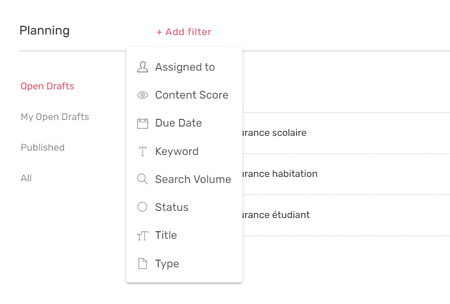
Example of combined filters:
You can filter your "Updated Content" drafts for which the Focus Keyword search volume is higher than 1000 and the Content Score lower than 50. This will give you a list of Drafts with high SEO potential, which the content deserves to be reworked as a priority. You can then ensure that each of the drafts resulting from this combination of filters has an assigned collaborator and a nearby due date.
- Exporting content recommendations
During your production process, you may need to export Semji's recommendations in an Excel file to use them outside the Platform. Semji allows the export of some Optimizations of a Draft:
- Search Intents (only the unlocked ones)
- Related Terms
- Questions
To do this, in the planning tab, select the drafts concerned and click on the left of the content title.
As soon as you have selected 1 or more contents, new options will appear in the table column headings.
You can then click on the export symbol.
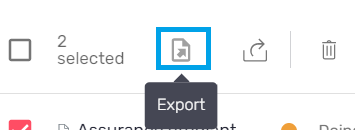
- Publish content in bulk
Reminder : Reporting content as published consists in clicking on the "Mark as Published" button inside the editor of a draft. This action informs Semji about the publication date and the final url of a content in order to retrieve traffic, conversion and other SEO KPIs that will be useful to analyze the performance of your content.
In your internal production process, it is possible that you are in charge of the integration of the contents in the CMS and their publication, or that this mission is managed by a specific collaborator. In these cases, it is common to integrate several contents on the same day. Therefore, if you need to report the publication of several contents at once in Semji Platform, you can use the "Bulk publication" feature.
To do this, in the Planning tab, select the relevant content.
As soon as you have selected 1 or more contents, new options will appear in place of the table column headings.
You can then click on the bulk publication symbol.
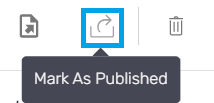
A window opens, you are invited to fill in:
- the official publication date (this date will be indicated by a pink dot on your performance graphs)
- each content's URL
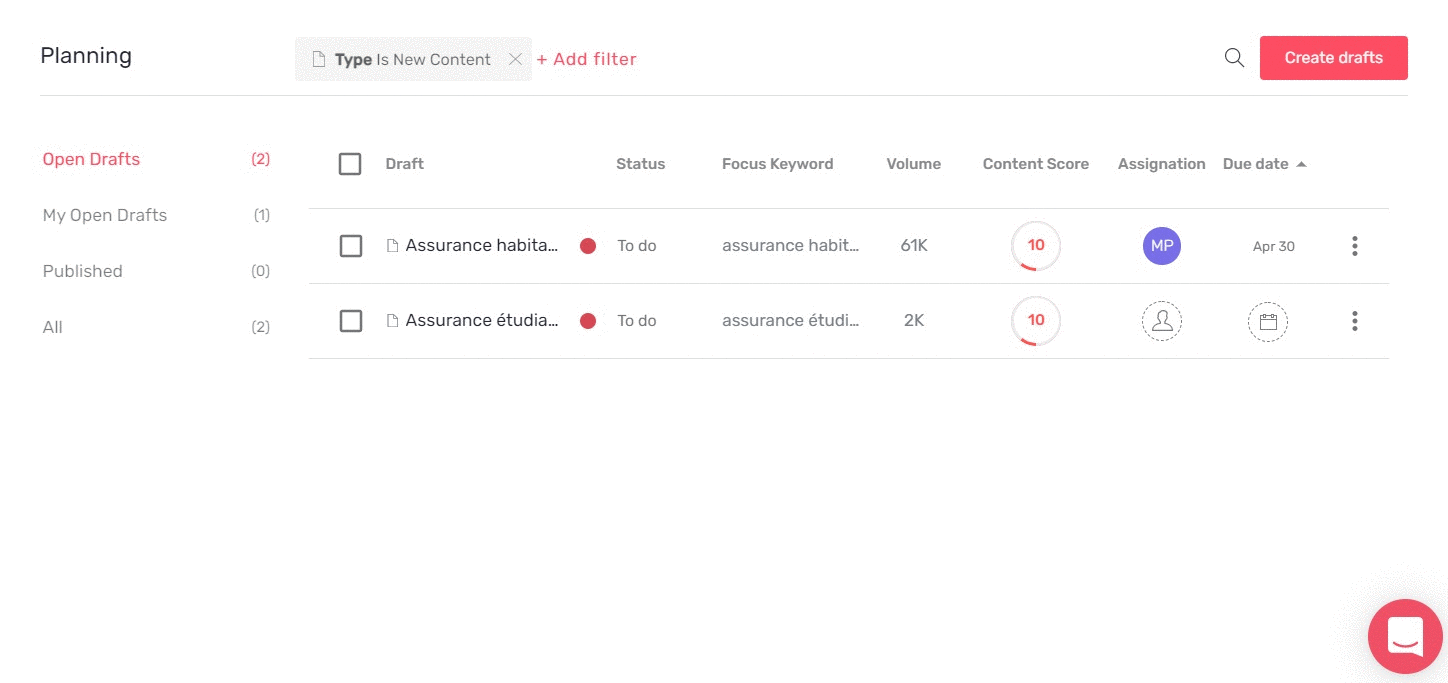
- Delete Drafts
You may need to delete a draft from the list, if the content is no longer part of your production schedule.
In the Planning section, click on the three vertical dots and select "Delete". In order to avoid mistakes, a message asks you to confirm. The draft will be deleted from your Planning after confirmation.
A noter : if you had spent an analysis to get the optimization recommendations, this analysis is not refunded.
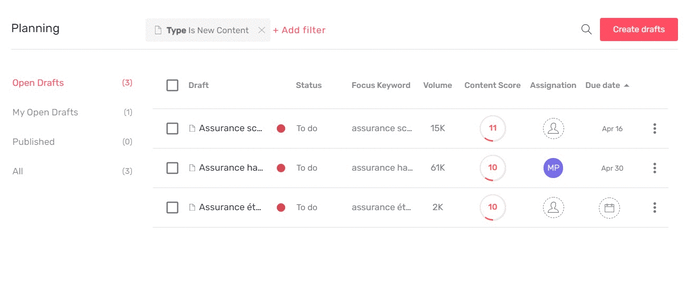
This feature is also accessible in bulk: again, go to the Planning tab and select the relevant contents by clicking on the checkbox (to the left of the content title).
As soon as you have selected 1 or more contents, new options appear in the table column headings.
You can then click on the delete symbol.

